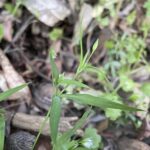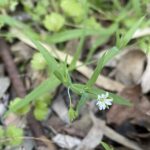Κεράστιον το αμφίβολο
Etymology of Cerastium dubium
The name of the genus, "Cerastium", comes from the Ancient Greek word ''κέρας" [keras], meaning horn, referring to the horn-like shape of the seed capsule. Latin "dubium" is an adjective meaning "doubtful" or "uncertain." Its application to this particular Cerastium species is interesting and might refer to a taxonomic confusion: It's possible that when the species was first described, there was some uncertainty or difficulty in distinguishing it from other closely related Cerastium species. The "doubtful" nature could relate to its intermediate characteristics or its resemblance to other taxa.
Cerastium in Cyprus
Around 8 Cerastium taxa (7 species and a subspecies) are believed to exist in the wild Cypriot habitat.
Cerastium dubium was last recorded in Cyprus in 1977
Cerastium dubium was initially recorded in Cyprus by Robert Desmond Meikle in his book "Flora of Cyprus 1", in 1977. It has not been recorded officially by anyone else ever since. The several specimens in the pictures were found on April 20th, 2025, in the village of Mandria, Lemesos district, at an approximate altitude of 800 meters. The fact that this plant has only been recorded twice, makes it a very rare species to encounter in Cyprus.
The characteristics of Cerastium dubium of Cyprus
The Cerastium dubium specimens that I have encountered in Cyprus exhibit the following characteristics:
Annual Habit
It completes its life cycle within one year.
Stems
Erect, often many-branched from the base, ranging from approximately 10 to 25 cm in height.
Leaves
The main characteristics that distinguish Cerastium dubium from other Cerastium species come from its leaves: The leaves are sessile (without stalks), narrowly lanceolate or linear-oblong, and can reach up to 4 cm in length and 2-5 mm in width. The leaves are glabrous (smooth) or sparsely and minutely viscid-glandular. Additionally, the apex ranges from acute to acuminate.
Inflorescence
The inflorescence of Cerastium dubium is generally lax and not densely packed, with a relatively small number of flowers or even a solitary one. The bracts are narrowly lanceolate.
Pedicels
The pedicels are typically 10 to 15 mm long during flowering, often reaching up to 20 mm or even slightly longer in other instances. During flowering, the pedicels are often erect or ascending.
Flowers
The petals are white and bifid (two-lobed), usually about the same length as or slightly longer than the sepals. There are typically 10 stamens.
Habitat
They were found on dry, disturbed ground.






